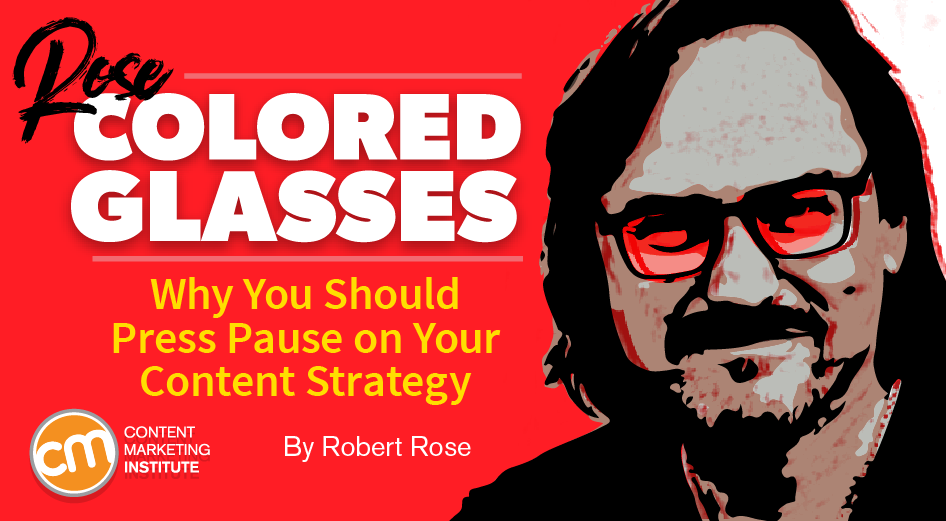MARKETING
Why You Should Press Pause on Your Content Strategy

June is the perfect time to reflect on your content and marketing strategy. What’s working? What isn’t? What needs to change going into the next season? What should we double down on?
But before you do. Take a deep breath. Pause.
Reflecting on anything in 2022 feels particularly challenging. COVID-19? Everybody’s got it. Global conflict? Almost as bad as can be. The economy? Slowing. Inflation? Rising. Ugly politics and unpopular decisions? Inevitable.
With so much negative news, it’s easy to make decisions around fear of loss rather than perceived gains.
It’s pretty much human nature.
It’s human nature to frame decisions around fear of loss rather than perceived gains, says @Robert_Rose. Is negativity affecting your #ContentStrategy? Via @CMIContent Click To Tweet
Losses distort gains
The concept of loss aversion describes how people feel the pain of losses more than the pleasure of gains. In other words, someone who loses $100 will lose more satisfaction than the same person would gain from a $100 win.
Loss aversion affects marketers all the time. You never send that “We’re going to unsubscribe you unless you opt-in” email for a simple reason: You’re more afraid of losing subscribers than you are excited about the possible increase in engagement levels.
A related theory, called loss attention, states that people tend to allocate more attention to a task or situation when it involves loss than when it doesn’t.
Put simply: When your attention is focused elsewhere, you might miss something. And most of us devote more attention to the places where we see loss.
Watch for the gorilla playing basketball
A light-hearted example of loss attention is the gorilla playing basketball video.
Researchers instructed viewers to count the passes made by the team wearing white. Afterward, they asked study participants if they’d noticed anything unusual.
Only 42% of the participants who counted passes made by the team wearing white saw the gorilla stroll through the middle of the game, beat its chest, and walk off. They put so much attention on avoiding the loss (failing to count correctly) that they didn’t notice something unexpected happening right before their eyes.
Now, I’m not suggesting that people should ignore these experiences or the world around them when reflecting on progress (or lack thereof) or making decisions.
Loss aversion and loss attention are natural human tendencies. In many instances, they’re good things. Loss attention can help with decision-making because it prevents us from seeing the “bright shiny object” that might otherwise distract people from the task at hand.
But raising your awareness of these concepts can stop you from overlooking progress you’ve made or failing to see what’s working despite current conditions and what’s failing only because of those conditions.
Don’t overlook what’s working in your #ContentStrategy despite current conditions – and what only failed because of those conditions, says @Robert_Rose via @CMIContent. Click To Tweet
Pause for focus
One tool that helps me balance is what I call a “pause for focus.” Sometimes I devote an entire week to this reflective period, and sometimes only a few minutes. I spend the time reframing what has happened, the implications of what happened, and how I get to change based on what happened.
I like using “get to” instead of “should” when it comes to change because it then frames change as an opportunity to do something new rather than to “fix” something perceived as broken.
My focus pause involves five simple questions. I take the time to write and really polish the answers.
- What are the three to five most significant areas of progress in the last [month, quarter, or whatever is the right time frame for you]?
- What are the biggest rocks in my way? Where am I stuck? Be specific.
- What are the top three actions I can get to take to become unstuck? (Doubling down or letting something ride count as actions.)
- What are the best-case and worst-case results for each of those actions?
- What is my biggest learning from the last [month, quarter, or whatever period you decided to reflect on]?
You won’t find the magic of this pause the first time you do it (though I still think you’ll find it helpful). You’ll find the real magic in the second, third, or fourth reflections as you assemble your answers over time.
Content marketing strategy checkup for 2022
Here are a few suggestions for topics and progress you might consider as you reflect on your progress, rocks, actions, and learnings:
- Are you building a content library or a content pile? You may create more content than ever before, but is your first thought leadership paper more valuable because the third, fourth, and tenth exist? Or are they all just random PDFs of thoughts no one evangelizes anymore? Are you building a webinar series in the model of a television network? Or are you holding random events about whatever you can gather?
- Have you architected and aligned points of view? Sure, you have editorial guidelines and brand guidelines, but do you have a consistent point of view across the business? Do you have thought leadership content that doesn’t share the same point of view or (worst) conflicts with the brand view?
- Are you creating content or filling containers? Is your content team built to help the entire organization communicate in a consistent, compelling way? Or are they simply filling containers (pages, posts, PDFs, podcasts, presentations) with words and pictures?
- Are you measuring both the denominator and numerator of content? You can measure content performance through visits, downloads, engagement, etc. But can you accurately measure the numerator – the costs, effort, and time that delivers that performance? And, finally, my tried-and-true favorite:
- If you stopped 100% of content production today (offline, online, editorial, marketing, advertising, product, and PR), who would miss it? Who would call, tweet, DM, or email to tell you they missed it?
If you stopped producing #content today, who would call, tweet, DM, or email to tell you they missed it, asks @Robert_Rose via @CMIContent. Click To Tweet
And now, the good news
Keep this in mind as you reflect on these questions: You’re not late.
As the saying goes, “The best time to plant a tree was 20 years ago. The second-best time is today.”
It’s the middle of 2022. So what if the best time for you to have made changes was six months ago? The second-best time is today.
HANDPICKED RELATED CONTENT:
Get Robert’s take on content marketing industry news in just three minutes:
Cover image by Joseph Kalinowski/Content Marketing Institute













You must be logged in to post a comment Login